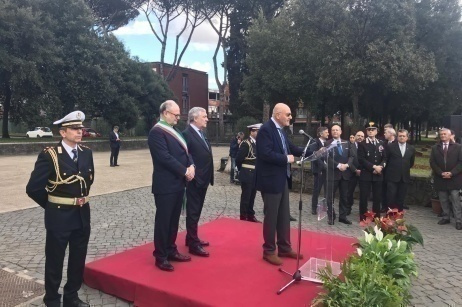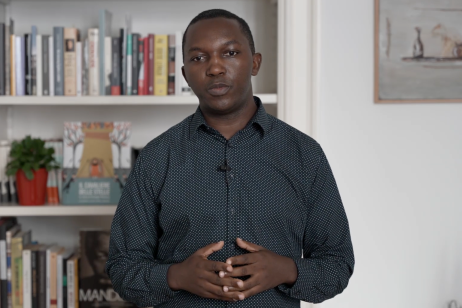
Here we publish the remarks of the anthropologist Craig Palmer about the value of creating the Gardens of the Righteous.
Gabriele Nissim recently called for the creation of Gariwo Gardens that “have no political colouring.”1 Further, he proposed that these Gardens should “stem the culture of contempt and enmity in the political debate” through fostering “forms of interaction and conciliation.” To accomplish this goal they should become “thought places, able to confront the public with new questions.” Being in full agreement with Mr. Nissim’s position, I offer an example of a type of Righteous act whose commemoration might be a way to take a small step toward this goal.
At first glance, the task of creating a Garden without a particular political color might seem easy to accomplish. For example, consider this saying attributed to Irena Sendler’s father: “Always remember, my darling Irena. If you see someone drowning, you must rescue him, even if you cannot swim.’”2 In a few short words this encapsulates the heart of the concept of the Righteous: an act of courageous and selfless caring for another human, whose commemoration can inspire others to perform similar acts of compassion. The saying is also significant for what it does not contain, because it illustrates how hypothetical descriptions of such acts can be both inspiring and devoid of any political context. In this example, the saying champions the importance of saving a single life, with no mention of the political affiliation of either Irena or the drowning man, and revealing nothing about how the man came to be in the river. As a result, the saying contains neither villains nor enemies, yet it helped inspire Irena Sendler to courageously take a leading role in the rescue of hundreds of people from perhaps the most unambiguous villain in human history.
Gariwo Gardens, however, go beyond hypothetical sayings and commemorate the actual behavior of real people that took place in a real world where there is always a political context. In many situations it is at least as important to document this political context as it is to describe the Righteous act. For example, to dissuade future generations from repeating the horror of the Holocaust the stories about the Righteous Among the Nations told by Yad Vashem not only emphasize the horrific details of how the man was pushed into the river, they devote great effort to establishing the identity and degree of culpability of all those directly and indirectly involved in that act. Indeed, within the context of the Holocaust: “There are no heroes without villains.”3
By extending Yad Vashem’s idea of Righteousness “from the Holocaust to all cases of totalitarianism and genocide,”1 the portrayal of political context in a Gariwo Garden faces a unique challenge. Like the acts commemorated by Yad Vashem, the inspiring acts commemorated in a Gariwo Garden took place within a political context containing villains as well as heroes. However, the inclusion of a wide range of examples and contexts beyond the Holocaust increases the chances that there will sometimes be disagreement among those visiting the Garden over who does and does not qualify as a villainous enemy. When this disagreement reaches the point where members of different political parties within the same nation view each other as the villain, a Gariwo Garden risks taking on the color of a particular political party and becoming just another means by which that party vilifies other political parties. This is particularly easy to envision in the United States where extreme members of both of the two opposed political parties call some of the members of the other party totalitarian fascists, and words like “contempt” and “enmity” fail to adequately describe what often masquerades as political debate.
However, even in such a polarized political context some individuals make choices that both inspire us and confront us with new questions. For example, like many places in the world, political rallies by groups in the United States often attract protesters who are vehemently opposed to the group holding the rally. During one such event a man was singled out by a group of protesters and accused of being a member of the organization they were protesting against. As the man became the focus of their anger, the protesters quickly closed in around him. When he ran, the previously peaceful protesters chased him and knocked him to the ground. As many of the protesters commenced to kick and beat the man with sticks, one teenaged protester made a choice. Seeing a man about to “drown,” she risked her own life and jumped into “the river” to try and save the man by throwing her body over his to shield him from the blows while imploring her fellow protesters to stop their attack.
This description of the young woman’s actions closely conforms to the story about jumping into a river to save a drowning man, except that it also includes the political context of the events described. It not only establishes that the actions took place within an atmosphere of political enmity and contempt, it clearly identifies which actors in the story (i.e., the person needing rescue, the rescuer, and those whose actions necessitated the rescue) were on the same and different sides of this political divide. However, instead of taking on the political color of either of these political factions, the story confronts all members of the public with new questions. For example, visitors who despise the political views attributed to the man are confronted with the question: Are the protesters heroes for attacking the man, and the young woman a villain for attempting to save his life? Conversely, visitors with political views similar to those attributed to the man are confronted with the question: Is the young woman a villain for being one of the protesters, or does her attempt to save the man’s life make her a hero? All of the visitors to the Garden would also be confronted with questions about how their answers were influenced by the specific identities and political ideologies of the people involved.4
Ideally, presenting stories such as this one in Gariwo Gardens might be one way of making them not only places of thought, but places where those thoughts are shared in civil discourse between individuals with opposing political viewpoints. This does not mean that people with different backgrounds, experiences, and political ideologies will, or should, necessarily agree about which actions and actors are villainous. However, the mere fact that the discussions take place between individuals who have just been exposed to a description of what they can all agree was a courageous act of caring for others may increase the chances that the interactions lead to some degree of conciliation. If this is true, it is just one of the many ways Gariwo Gardens could have a positive influence on the culture of contempt and enmity currently existing in the United States.
1 Nissim, Gabriele. “The Message of the Righteous.” https://en.gariwo.net/editorials/the-message-of-the-righteous-19678.html
2 Mayer, Jack. 2011. Life in a Jar: The Irena Sendler Project. Long Trail Press: Middlebury, Vermont, p. 105.
3 Schulweis, Rabbi Harold. 1988. “Foreword” pp. ix –xiv, In Oliner, Samuel P. and Pearl M. Oliner. 1988. The Altruistic Personality: Rescuers of Jews in Nazi Europe. The Free Press: NY, p. ix.
4 Those wishing to be confronted by such questions can start to learn about the details of this event here: https://en.gariwo.net/righteous/the-righteous-biographies/civil-courage/exemplary-figures-reported-by-users/keshia-thomas-19592.htm







